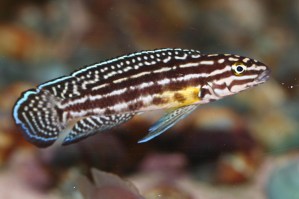 |
Julidochromis marlieri |
 |
||||||||||||||||||||||
|
|
|
|
||||||||||||||||||||||
| Explanation of the symbols | ||||||||||||||||||||||||
|
|
|
|||||||||||||||||||||||
|
||||||||||||||||||||||||
|
Toward their own species they are very aggressive. You
should keep them as a pair. The aquarium should be set
up with stones and rocks to create holes and hiding places.
In the middle you should leave enough free swimming space. They
make a territory. You can use some plants like Vallisneria to decorate the aquarium. They are omnivorous. You should give them a great variety of live, frozen and dry food. Breeding is easy at higher temperatures. Up to 360 eggs are laid and fertilized in a cave. The parents defend the territory. This species crossbreeds easily with Julidochromus ornatus. Young fishes of this crossbreeding are not fertile. |
||||||||||||||||||||||||
|
|
||||||||||||||||||||||||
|
Jan Bukkems |
||||||||||||||||||||||||
 |
||||||||||||||||||||||||
|
Copyright ©AV AquaVISie. All rights reserved. |
||||||||||||||||||||||||
